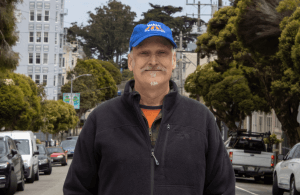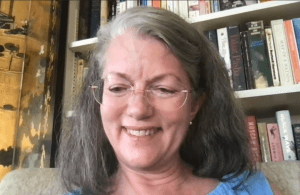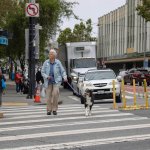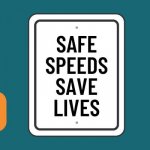How Walk SF started: an inspiring interview with founders Betsy Thagard and Michael Smith
With Walk SF celebrating its 25th anniversary, I was curious: what’s the whole story on how the organization got off the ground?
I went straight to the source to answer this question. Earlier this summer, I sat down with Michael Smith and his hyper-affectionate cat Funston at Michael’s home in the Panhandle. We Zoomed with Betsy Thagard, who now lives in Washington, DC.
Betsy and Michael were core founders of Walk SF; Michael is still deeply involved today. And our conversation blew me away.
I was shocked by the state of affairs for pedestrians when Walk SF was first started – more than twice as many pedestrians were dying each year. I was inspired by how from the very start, Walk SF was a scrappy, solutions-oriented voice for the most vulnerable on our streets. It turns out we’ve always been making signs and showing up at City Hall!
I was also really moved by the countless volunteer hours Betsy and Mike gave to Walk SF in the early years, the vision they had, and their pride today in what Walk SF has accomplished over 25 years (read more in our impact report).
Here are some highlights from my conversation with Betsy and Michael. If you want to share your gratitude with them, email me at marta@walksf.org and I’ll pass on your message!


Marta, Walk SF: How did Walk SF start? And what was it like in San Francisco 25 years ago from the pedestrian perspective?
Michael: Well, I’ll start with my side of things – I, with a bunch of friends, we talked a lot about how what the city really needs is a pedestrian advocacy group. But we didn’t do anything. And then I got a phone call from a friend, and he said, “Have you heard about Walk SF? This group started, and they’re doing what we’ve talked about.” So then I reached out to you, Betsy, and, and got involved. You had actually started things first, on your own. And then I joined in when I heard about it.
Betsy: Yeah. I was on the board of the Bicycle Coalition. A group of us started talking about how we need a separate pedestrian advocacy group.
Michael: Right. And there was also the group called Rescue Muni. So those two things [biking and transit] were covered. But everybody’s a pedestrian, and yet there was no representation for pedestrians. So it was obvious that we needed to get people together to be a voice for pedestrians.
Betsy: The number of pedestrians dying was awful.
Michael: Yeah, people complain about the lack of progress with Vision Zero and all, but there were more than twice as many fatalities when we first started.
Betsy: Awful things. I think one of the ones who got me most upset was a group of preschoolers crossing in a crosswalk. It was on Lake Street. A driver was talking on his phone and plowed them down. Note: The children were not fatality hit.
Marta, Walk SF: Oh my gosh.
Betsy: I can’t raise my children in this city if this kind of thing happens. That’s how I felt about it.
Marta, Walk SF: I have two kids myself that I’m raising in this city, and those crashes are just sickening.
Michael: At the time, there was nobody at SFMTA who was even responsible for pedestrian issues. So one of the first things that we (Walk SF) tried to do was to make sure that they hired somebody.
Betsy: And we demonstrated. Right, Mike?
Michael: Yeah!
Betsy: We were on the steps of City Hall regularly.
Marta, Walk SF: So Walk SF was about advocacy and action from the beginning. I love that. The passion and the fire have always been there!
Michael: I think there are some interesting initial battles that are not really known about. One of the first was sidewalk parking.
Betsy: We’re talking people would park across the entire sidewalk, everywhere. So then everyone had to walk in the street.
Michael: And before that, back in the eighties, people just parked in bus stops all the time. But then the city started cracking down on that, and now you never see people park at bus stops. And before, people were parking all over the sidewalk. It was only a $25 fine and the city never wrote any tickets. And so it was known that the sidewalks were often the cheapest place to park! We were able to raise the fine to a $100 and to publicize the issue so people realize that you can’t park on the sidewalk. It’s still a problem, but people don’t realize that it used to be ten times worse.
That was the first big success that put Walk SF on the map. The other thing was Segways. Remember the Segway scooters? Segway was going around changing laws to define people on Segways as pedestrians. They were saying that this is going to really enhance the pedestrian environment because people will be able to go faster. And there was a lot of hype behind it. People thought Segways were going to be everywhere, and how everyone got around.
We teamed up with what at the time was called Senior Action Network. Dean Kamen, who was the inventor of the Segway, came to a meeting in San Francisco and we had a picket of seniors on the sidewalk with signs against the Segways outside the meeting. This was on the TV show 60 Minutes. And we got Segways banned from the sidewalks of San Francisco. Note: Walk SF advocated for and successfully passed the nation’s first policy banning Segways from sidewalks in 2002.
It didn’t really matter because Segways, of course –
Marta, Walk SF: They didn’t exactly take off.
Michael: Yeah. But it was a way to say that, you know, sidewalks are for pedestrians. They’re not for vehicles.
Michael: Also, the city refused to put in ladder crosswalks. Note: ‘Ladder crosswalks’ are also known as zebra-striped crosswalks, high-visibility, or continental crosswalks and increase the likelihood of a driver yielding to a pedestrian by 30 – 40%.
Marta, Walk SF: What?!?
Michael: Yeah. The city actually said that it’s too expensive, and then the city said that they only want ladder crosswalks by schools. And if they put ladder crosswalks everywhere, it would dilute the effect near the schools. Like, people wouldn’t appreciate them as much. And it was a big battle. It took a long time. But now all crosswalks put in are ladder crosswalks.
Marta, Walk SF: This is one of the cheapest, proven, fundamental pedestrian safety solutions today.
Michael: Another battle was double turn lanes. Walk SF was trying to get rid of all double turn lanes because they’re inherently dangerous.
Marta, Walk SF: They certainly are.
Michael: The City promised that they would try to get rid of all of them. They would study every double turn lane. And I think they got rid of one, and then they just stopped. And then, just last year, a little girl in a stroller was killed in an intersection with a double turn lane. And so the City has promised once again to fix them. Note: All double turn lanes in San Francisco are now banned and removed.
Marta, Walk SF: That’s a very hard story to hear. I think about that child and her family a lot.
Michael: Yeah…Yeah.
That it was supposed to happen 20 some years ago. And it didn’t.
Betsy: Mike, do you remember how we would paint the outlines of people in the middle of intersections?
Michael: It was really one person who started it. Every time a pedestrian was killed, he would go out at, like, four in the morning, and he would paint an outline of a body on the road. And boy, did that get attention.
Betsy: We really had to start getting people to think about themselves as pedestrians who were in danger.
Michael: And we needed the media to talk with Walk San Francisco, which is really important. Because before, they never presented the pedestrian side of things.
Betsy: They would just report another death on the streets as “Oh well.”
Marta, Walk SF: I’m just so grateful to you all for starting this, because when pedestrian deaths are not acknowledged that’s just so wrong. People need to see what’s happening and not be complacent. It’s so inspiring to me that this organization was all about that from day one.
Betsy, what do you hope for in the next 10 years or 25 years for pedestrians?
Betsy: I’d like to get rid of these gigantic cars.
Marta, Walk SF: I hear you.
Betsy: I’d like to see it be like Barcelona. Downtown Barcelona. Where you just can’t drive in the middle of the city anymore. It’s just all people now. So many people walking. No cars.
Once you reach the critical mass of places where people can see how beautiful it is, like JFK Promenade, then people can start to envision change and why it would be good. That’s how I feel when I go to Barcelona or one of the European cities that has done so much to prioritize people and safety. I can see that so many people are now enjoying having their city back.
Michael: And it’s not that Barcelona has always been that way.
Betsy: No, no, those cities were filled with cars 25 years ago.
Michael: So it shows that it can be done, and then people really like it once it has been done. Some people think that it’s radical, it’s never been done before, and it’s not true. We know this works.
Marta, Walk SF: Michael, what do you hope for in the next 10 years or 25 years for pedestrians?
Michael: Too often, there’s these good things for safety that should happen, and loud voices can delay it or stop them, even though they can be a minority and wrong. We have to get beyond having just a few people able to block what’s good and necessary for our safety and our city.
One real inspiration for me is Janette Sadik-Khan. She was the head of the Department of Transportation in New York City and she revolutionized it, like the transformation of Times Square. She just said, hey, “You know, we don’t need cars on Broadway. We’ll just make this into a plaza.” And when they would have the community input, it wasn’t about should this project happen or not happen. She said, “No. The city has decided that we have a safety problem. We have to improve things here. But we want your feedback. We want your feedback on how to make the best improvement. You know, how can we go about this to make it the best possible?” And I think that was really important because it allowed her to get a lot more done.
Marta, Walk SF: What do safe streets mean to you personally?
Betsy: I like to walk everywhere. And I just want to feel safe. The older I get, the more I realize how important it is to feel safe. Feeling safe is the beginning step.
Living here in DC, one great thing is there are red light cameras everywhere. The citations have gone way down because everyone knows [about the cameras]; it’s just great.
Marta, Walk SF: San Francisco will pilot 33 speed cameras starting in January. That was one of the things I’m most proud of in Walk SF’s work. Walk SF really led on this and worked on passing state legislation allowing this – for six years! It’s such an important start in harnessing a proven, lifesaving tool that other cities are already using. Washington, DC has more than 100. I’m jealous.
Michael: Even though I talk about safety a lot, what I’m really interested in is livability. I want where I live to be as livable as possible. That means enjoying where I live. And so, if I’m going to the store or whatever, it should be pleasant, not scary. It’s that simple. And so, I want to see if we can agree on the goal of livability, and safety is the canary in the coal mine.
Betsy: Exactly. Feeling safe is the beginning step.
And you can smile at other people while you’re doing it.
Michael: Right. It’s more human.
Betsy: And I think it’s important to bring in the word community too. I mean, that’s what I felt I was seeing when I went to JFK Promenade before moving to Washington, DC. This space had suddenly been opened up to be a place where people could form community.
Michael: I think if we work really hard, and we support Walk SF and other groups, we can get this done. We have made a lot of progress, and people don’t always appreciate that. Now we need to do the same thing again for the next 25 years.
Betsy: I’m still a member of Walk SF. I read the newsletter and it makes me smile to see what you are doing. You’ve got policies, strategies, you’ve got staff, you’re thinking way ahead so you can be pushing for change over the long haul. You’ve kept at it and kept at it. And that makes all the difference.
Michael: That’s really true.
This blog is dedicated to everyone who was part of getting Walk SF off the ground 25 years ago – and everyone who has supported our mission in ways big and small since. It truly takes a village and we couldn’t be more grateful to the village! Every Walk SF member makes us stronger and able to win transformative changes to our streets for a safer, people-first future.




